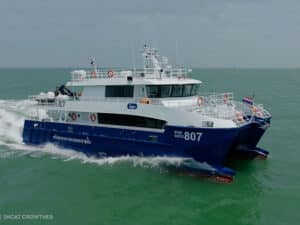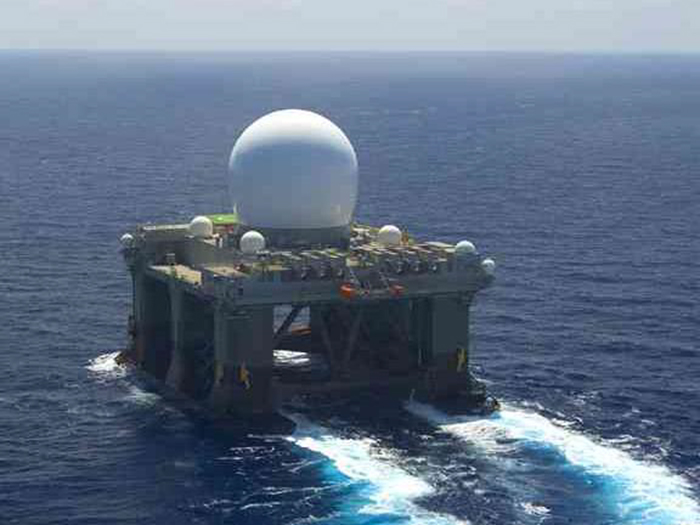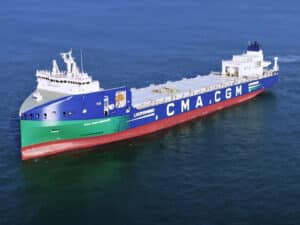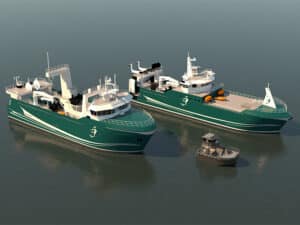
EBDG weld procedure reduces downtime for critical defense asset
Written by Marine Log Staff
SBX-1 is based on a semi-submersible hull [Image: USN/TOTE Services]
PROCURE AND PREP
EBDG obtained approval from ABS to create the test assemblies using both applicable grades of steel in one weldment. Combining the two steel grades into one assembly effectively reduced the cost and effort of the testing by 50%. Due to the exotic nature of the material and limited supply, we sourced the steel from two separate mills, one domestic and one overseas. EBDG directly purchased the steel from both suppliers, and coordinated shipping and customs import from the overseas vendor.
All bulk plates were shipped to Chapel Steel in Portland, Oregon. At Chapel Steel, the plates were broken out into smaller pieces for the test assemblies, and bevels were cut on the FH36 plates. Chapel used their “high definition” plasma cutting process to provide clean, accurate cuts that required only minimal additional preparation prior to welding.
FABRICATION
EBDG partnered with Industrial Resources Incorporated (IRI) at its Sedro Woolley, Washington location for fabrication and welding of the test assemblies for the range of weld procedure configurations. EBDG worked with IRI to identify weld parameters that would both satisfy the material property requirement and be usable for the real-world fabrication on the vessel. EBDG determined the widest range possible on the critical weld parameters that would then give the most possible flexibility in weld machine set-up, which helps accommodate a range of welding techniques between different operators.
At IRI’s fabrication shop, test assemblies were welded using a matrix of preheat values and heat inputs that allowed us to understand how the different inputs affected the critical material property of low temperature toughness. The test assemblies were prepared in both the vertical (3G) and horizontal (2G) positions to provide a procedure that can be used for the joint orientations on the vessel. The gas shielded flux-core process (FCAW-G) was used for the welding, and a propane “dragon’s breath” torch was used for preheating the assemblies to 350 degrees F. The joints were single bevel with ceramic backing for the root pass, as per client specification. The extra nickel content in the FH-36 plate proved to be a challenge to maintain puddle shape without slumping for the horizontal position. EBDG worked with IRI to fine tune the joint dimensions, root gap, and weld parameters to encourage high quality welds in either position. EBDG observed, inspected, and recorded every weld pass on each test assembly.
IRI’s fabrication skills and EBDG’s theoretical and practical weld knowledge were crucial to the success of the project.
TESTING
EBDG employed the Mistras Group (Mistras) in Burlington and Ferndale, Wash., to provide nondestructive and destructive testing of the completed test assemblies. Mistras delivered prompt, expert testing services that kept the project timeline on track. EBDG and ABS were on site to witness the testing.
EBDG first evaluated the completed test assemblies via a visual inspection by our American Welding Society (AWS) Certified Welding Inspectors (CWI). Then Mistras provided nondestructive X-ray and dye penetrant examination. From there, the assemblies were processed by Mistras into destructive test coupons.
The type, quantity, and methodology of the testing was performed in accordance with ABS requirements and AWS D1.1 Structural Welding Code – Steel, as follows:
- Visual inspection
- Surface crack detection (dye penetrant)
- internal defect detection (X-ray)
- Transverse tensile test
- Transverse bend test
- Charpy V-notch impact test
- Macro etch examination
- Hardness test
To conclude the program, EBDG prepared a final revision of the weld procedure, compiled the applicable testing documentation, and submitted the package to ABS for regulatory review and approval. ABS also provided onsite witness during the fabrication and testing throughout the project. EBDG worked closely with ABS’ engineering team during their review to satisfy their questions and obtained prompt approval of the final procedure
REGULATORY APPROVAL
To conclude the program, EBDG prepared a final revision of the weld procedure, compiled the applicable testing documentation, and submitted the package to ABS for regulatory review and approval. ABS also provided onsite witness during the fabrication and testing throughout the project. EBDG worked closely with ABS’ engineering team during their review to satisfy their questions and obtained prompt approval of the final procedure.
CONSTRUCTION
As final proof of the success of the procedure development, it was successfully implemented by the shipyard with the final welded joints passing all quality assurance and performance requirements.




